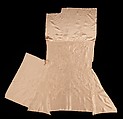Textile piece
Designer Sarah Lipska Polish
Not on view
This object is from a collection of sample embroideries, which was originally owned by Morris de Camp Crawford, editor of Women's Wear Daily, who collected objects which told the story of fashion and fabric history. Included in this collection was a group of textiles which illustrated what American and French designers and manufacturers were using. According to Crawford's book The Ways of Fashion, the work of Polish artist Sarah Lipska (1882-1973) was represented in this collection. Lipska is an enigmatic figure, who is known to have worked with Leon Bakst as a set and costume designer for the Ballets Russes, and later in the 1920s as a fashion designer in Paris at 4 rue Belloni, and finally as a sculptor. Extant examples of her work are rare. Although only a few pieces in the Brooklyn Museum collection bear a label or a signature, others bear hallmarks of her work, such as a distinctive form of whip stitching on appliqué work, unusual abstract motifs, and Cubist-inspired patterns.
This unfinished dress clearly shows the process of designing embroidery for a specific dress. The seams and basting stitches which outline the silhouette were done first. Then the embroidery was applied over the seams and basting stitches, maximizing the effect of the embroidery and allowing the design to be fully represented. The embroidery design itself is subtle and sophisticated. Lipska, the probable designer of this piece, chose to use wool thread in a slightly variant shade of cream than the ground fabric, creating a chic textured effect against the sheen of the crepe-back satin.
This image cannot be enlarged, viewed at full screen, or downloaded.
This artwork is meant to be viewed from right to left. Scroll left to view more.



